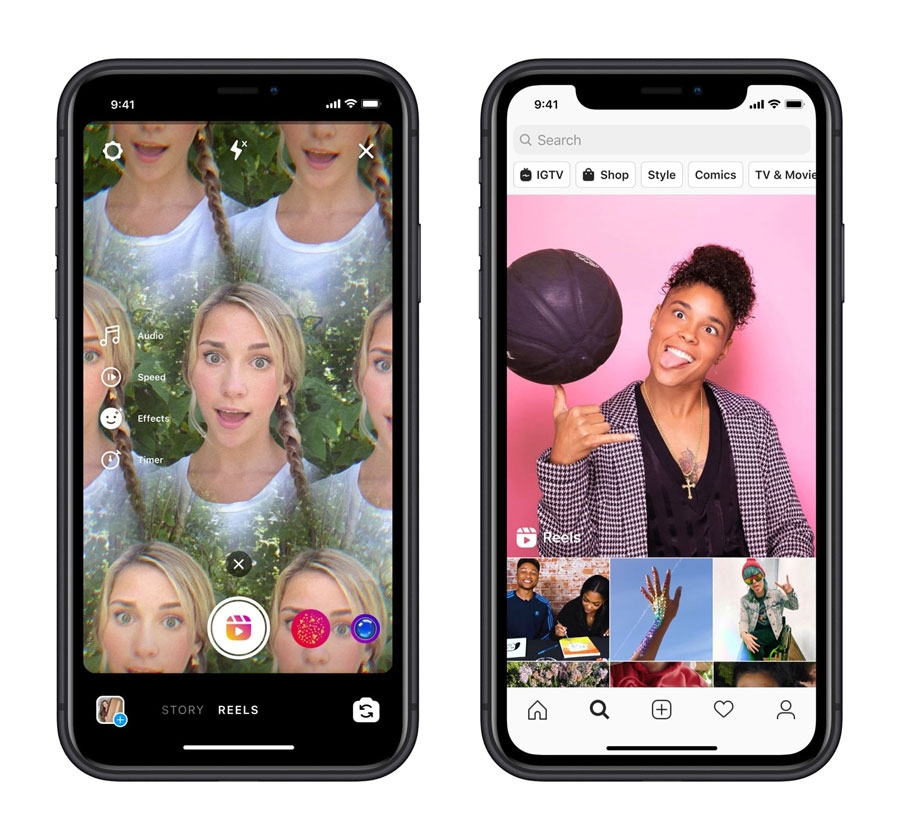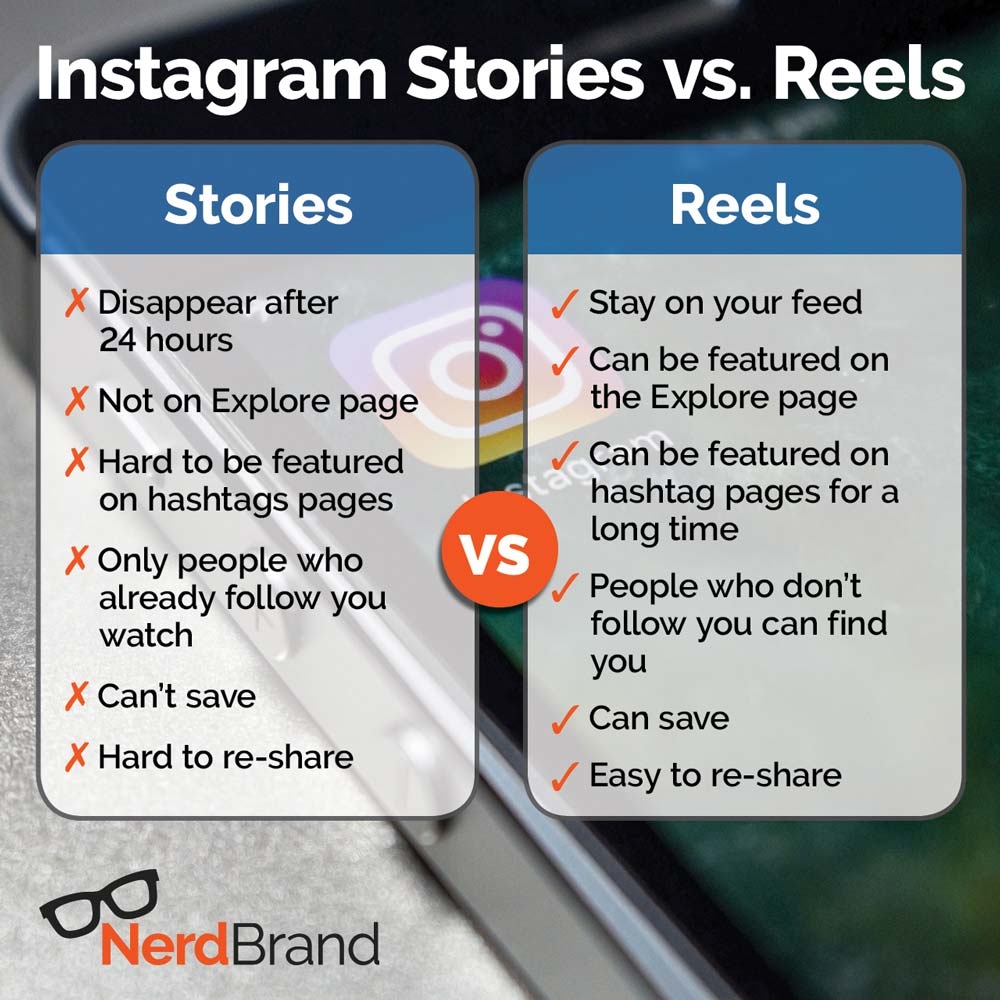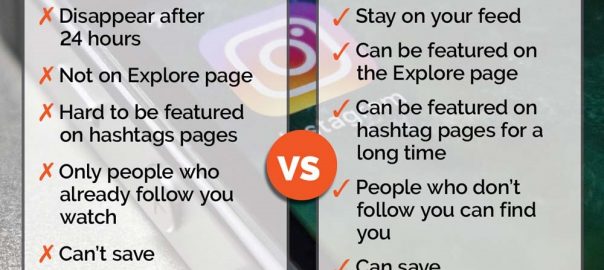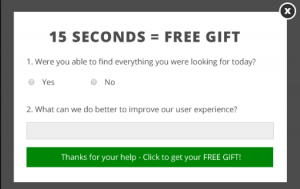By now, I’m sure you’re aware of Instagram’s short, punchy, and entertaining video clips called Reels.
Since its launch in 2020, the use of Reels has grown tremendously.
As a business owner or marketing manager, I know resources and budgets are finite. So, you’re faced with a few questions:
- Should my brand be present on a new platform like TikTok?
- Should my brand be taking advantage of new features on social platforms, like Reels and IGTV?
- How can I get started entering these new marketing channels, especially given the skills, budgets, and resources available?
Tough decisions, we get it. So, let’s take a look at TikTok vs. Instagram Reels to see what direction makes the most sense for you.
What are Instagram Reels?
Instagram Reels allow users to create up to 60-second video clips that can be set to audio and music. You can also apply filters and effects. Reels can be shared to Stories, the Explore feed, news feed, and the new Reels tab on a user’s profile.

These channels for sharing make Reels an excellent avenue for increasing your reach on Instagram and growing awareness of your brand.
How are Instagram Reels different from Instagram Stories?
Reels are often made with more formal production in mind. They’re a fun way to hop on trends and create short, entertaining videos that remain published long-term on your profile.
Reels offer more editing tools than Stories, like speed and additional AR (augmented reality) effects, so you can really get creative.
Another important difference is that Reels can be saved by users. When a user saves your Reels, it indicates to Instagram that they’re loving your content. In turn, the algorithm may reward your content with increased organic reach.

Stories, on the other hand, are more transient and disappear after 24 hours. They help users share quick updates in-between their regular posts.
Stories are beneficial in that you can post many times over a short period without flooding your followers in the feed or negatively impacting your profile’s appearance.
All in all, Reels and Stories have different purposes for being used. Neither is necessarily better than the other. They’re simply distinct content creation and storytelling tools for your brand.
Are there differences between Instagram Reels and TikToks?
TikTok is a social platform created specifically for short, interactive video content. Aside from Vine’s short-lived popularity and Musical.ly, which evolved to the current-day TikTok, you might consider TikTok the originator of this short content format.
Reels were released by Instagram a short while after TikTok started to gain mainstream popularity.
Much like Instagram’s introduction of Stories to combat Snapchat, the addition of Reels is Instagram’s effort to undercut TikTok’s novelty and rapid growth.
This is especially important because TikTok has built a stronghold among an audience that’s very important to Facebook and Instagram: people under the age of 25.
Time will tell if Instagram can successfully reengage younger audiences with the enthusiasm they have for TikTok.
All in all, Reels and TikTok share many similarities in format. But there are some key differences you should know about.
Style of Content
Some would argue that Instagram is a platform for more polished and produced content. So, naturally, this expectation carries over to Reels. On the flip side, TikTok tends to offer more raw, spontaneous content.
This can either be a pro or con, depending on your business’s resources to produce video. Don’t be discouraged from experimenting. But in general, Instagram Reels are expected to show the finer details of production.
In-app Editing Features
A significant difference that users point out is in-app editing capabilities. TikTok offers more editing options and the ability to rearrange clips to build a finished video.
You can also add voiceover effects in TikTok, which Reels doesn’t offer. Voiceover videos have turned out to be a prevalent style of storytelling on TikTok.
Filters
TikTok trends often arise from specific video effects, like filters. And TikTok does an exceptional job of letting you customize your videos.
The Reels equivalent is not quite as expansive but does offer filters. Unfortunately, filters and effects are not separated on Reels, which means you can only choose one. So, the appearance of your finished video may have less versatility than your usual TikTok.
A final key difference is that you must select an effect or filter before filming a Reel. On TikTok, you can apply filters and effects after taking a video.
Music Selection and Licensing
Due to copyright concerns, Instagram business accounts only have access to Reels’ library of royalty-free music. Or you can upload your own sounds. That can be a bit limiting in creativity.
One of TikTok’s clear advantages is its entire music library is accessible to everyone on the platform. And it shows in the trends that catch on within the platform.
Captions and Comment Limits
Reels have a caption limit of 2,200 characters. TikTok’s caption limit is 100 characters.
Obviously, that’s less real estate to get your message across, so TikTok videos must carry the weight of really selling the point.
That’s not necessarily a bad thing; it just requires a different approach. Much like using Twitter vs. LinkedIn — similar approaches, but Twitter requires brevity due to its short character limit.
For better or worse, commenting on TikTok is limited as well. You’re lucky to be able to fit three sentences into a comment. So, if you’re trying to get long-form feedback or create a community where educational discussions are critical, Reels may be a better avenue.
Paid Advertising
Aside from partnering directly with influencers on the platform, there are many ways brands can advertise on TikTok. Previously, TikTok was very exclusive in its advertising options, only allowing big-name brands to take advantage.
Costs of advertising on TikTok have dropped significantly since 2020, and the ad platform has enabled several standard advertising features, including targeting by DMA.
Five of the common TikTok ad types are below:
- Brand Takeover Ads
- Top-View Ads
- In-feed Ads
- Hashtag Challenges
- Branded Effects
That said, there have been some frustrations with TikTok expressed by media buyers.
Some complain there’s limited ability to scale campaigns. Meaning, a campaign will start very promisingly, then quickly taper off in performance. There have also been complaints about TikTok’s customer support being less-than-helpful, billing issues, and ad account bans without explanation.
Advertising with Instagram Reels
Instagram’s ad platform, on the other hand, is, of course, powered by Facebook. Arguably the most effective ad platform ever. So, you have incredible targeting opportunities with Reels ads.
Advertising within Instagram Reels is relatively new.
Reels ads are full screen and vertical, similar to ads in Instagram Stories.
They appear in between individual Reels. As with regular Reels content, the ads loop and can be up to 30 seconds. People can comment, like, view, save and share Reels ads.
Reels ads can appear in the most popular places to access Reels content, including Reels tab, Reels in Explore, and Reels in your feed.
Is TikTok better than Instagram Reels?
The question of which is better depends on why you’re using the platforms.
- Do you want to promote your business?
- Are your customers typically below age 35?
- Do your customers look to your brand for informal content and entertainment?
- Are you trying to grow your following as an independent creator?
These questions and more are essential any time you’re thinking about entering a new social channel.
It’s impossible to be everywhere all the time. If you spread yourself too thin, the quality of content will decrease, and your presence within a channel will dissolve as it gets less attention.
So be honest with yourself. Be practical in acknowledging the skills and resources you have available in your business.
Why Reels?
That said, Instagram Reels is a great place to meet your audience where they already spend time, especially if you have a good Instagram presence overall.
Because Reels is simply a feature built into the machine that is Instagram, success can be a lighter lift. Not only does your existing audience see your reels, but they can also get looped into your other content in stories, feed posts, IGTV, and shopping.
That creates a “sticky” experience and keeps customers intertwined with your brand.
Why TikTok?
TikTok is a little different.
Being a new platform, you’ll be starting from scratch to build a presence.
And unlike Instagram Reels, TikTok is not a part of a more extensive set of features that can grab and retain customers’ attention.
While that might appear to be a huge disadvantage, I don’t want to spin it negatively. TikTok is thriving! It’s like the early days of Instagram, where organic reach was exceptional, and the novelty of the platform excites the community.
Impressing users and the algorithm on Instagram is very tough compared to TikTok.
On TikTok, there’s simply less content in the feeds. Meaning there’s less competition for eyeballs.
Because of TikTok’s novelty and the number of users, the algorithm is much more friendly in pushing content out to non-followers. Much the same way Facebook and Instagram used to give hordes of organic reach on almost any post.
TikTok’s content is powered mainly by creative individuals and consists of life hacks, trends, and people simply having fun. Entertainment is the key.
Reels, as mentioned, are a bit more polished, used more by brands, and are just an addition to other Instagram features.
Overall, both options can serve well for marketing your business. The driving factor in your decision about where to invest time and resources largely depends upon what you envision as the outcome, your product, and your target market.
Just like every other marketing channel decision.
Digital & Social Articles on Business 2 Community
(137)
Report Post








